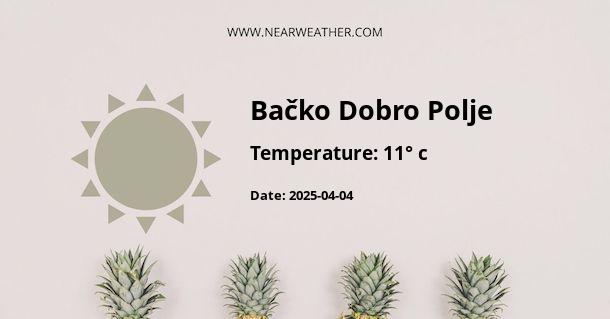Climate and Weather Overview of Bačko Dobro Polje, Serbia
Bačko Dobro Polje is a small settlement in the Vojvodina province of Serbia, and it experiences a continental climate which brings distinct seasonal variations. Understanding the climate and weather patterns is essential for agriculture, planning events, and daily life activities in the region.
General Climate Classification
The climate of Bačko Dobro Polje is classified as humid continental according to the Köppen-Geiger climate classification system. This type of climate, designated as Dfa, is characterized by large seasonal temperature differences with hot summers and cold winters.
Seasonal Weather Patterns
Spring
The spring season in Bačko Dobro Polje sees a gradual rise in temperatures and increased daylight hours. The following outlines the typical conditions:
- Temperature: A range of 5°C (41°F) to 15°C (59°F), with gradual warming through the season.
- Precipitation: Moderate – with frequent rain showers heralding the start of the planting season in farming communities.
- Plant Growth: This season experiences the awakening of local flora, with blossoms and greenery reemerging.
Summer
Summers in Bačko Dobro Polje are typically warm to hot and sometimes humid, with the following key characteristics:
- Temperature: Average highs range from 25°C (77°F) to 30°C (86°F), occasionally exceeding 35°C (95°F) during heatwaves.
- Precipitation: Summer can have thunderstorms and occasional downpours, albeit less frequently than in spring.
- Agriculture: This is a critical period for crop development, demanding careful irrigation and crop management from local farmers.
Autumn
The autumn season introduces cooler weather and the harvest period, with conditions gradually shifting as follows:
- Temperature: Decreasing from mild to cooler ranges, temperatures move from early autumn highs of around 20°C (68°F) to late autumn around 5°C (41°F).
- Precipitation: Rainfall increases again, contributing to the preparation of soil for the next planting season.
- Harvest: This time is crucial for farmers to harvest summer crops and prepare the ground for winter crops.
Winter
Winters are cold, with a higher likelihood of snow, making this a challenging season, particularly for outdoor activities:
- Temperature: Averages range from -2°C (28°F) to 5°C (41°F), with potential cold snaps bringing temperatures well below the freezing point.
- Precipitation: Snowfall is common, impacting transportation and daily life.
- Hibernation: The cold months are a time for some wildlife to hibernate, while others migrate to warmer climates.
Detailed Climatic Data
For a more precise understanding, examining detailed climatic data is important. Temperature fluctuations, precipitation patterns, and other meteorological data play a significant role in agricultural planning and daily routines.
Monthly Temperature and Precipitation
Here's data typical for a location with a humid continental climate like Bačko Dobro Polje:
| Month | Average High (°C) | Average Low (°C) | Precipitation (mm) |
|---|---|---|---|
| January | 1 | -5 | 37 |
| February | 5 | -3 | 35 |
| March | 11 | 1 | 40 |
| April | 17 | 6 | 48 |
| May | 22 | 11 | 58 |
| June | 25 | 14 | 84 |
| July | 28 | 16 | 66 |
| August | 28 | 16 | 58 |
| September | 23 | 12 | 53 |
| October | 17 | 7 | 48 |
| November | 9 | 2 | 56 |
| December | 3 | -2 | 51 |
Extreme Weather Events and Natural Disasters
In Bačko Dobro Polje, as in many parts of Serbia, there is the potential for extreme weather events which can include:
- Heatwaves: Intense heat periods in the summer can affect public health and strain local infrastructure.
- Severe Thunderstorms: Can produce hail, strong winds, and even tornadoes, resulting in property damage and farming losses.
- Heavy Snowfall and Ice: During winter, heavy snow and ice can disrupt travel and damage infrastructure.
- Flooding: Due to heavy rainfall or snowmelt, floods can threaten homes, agriculture, and natural habitats.
Climate Change Considerations
Climate change, evident in shifting weather patterns and increased frequency of extreme weather events, poses a significant risk to Bačko Dobro Polje. *
- Increased Temperatures: The region may experience a rise in average temperatures and more frequent and intense heatwaves.
- Altered Precipitation Patterns: Changes in timing and quantity of rainfall can affect agricultural cycles and water supply.
- Greater Weather Volatility: A higher incidence of storms and droughts could necessitate new strategies for infrastructure resilience and agricultural practices.
Adaptation Strategies
Adaptation strategies are critically important to cope with the impacts of climate change. These can include:
- Water Resource Management: Efficient irrigation systems, water conservation methods, and improved drainage can help manage water resources effectively.
- Agricultural Adaptations: Diversifying crops, implementing weather-resistant crop varieties, and adjusting planting schedules to fit the changing climate.
- Infrastructure Resilience: Building stronger, weather-resistant homes and public buildings as well as improving road and rail systems to handle extreme weather.
In summary, the climate and weather in Bačko Dobro Polje, Serbia, are characterized by their continental nature with clearly demarcated seasons. Residents and farmers in the area adapt their activities according to these seasonal variations. Looking ahead, the challenges posed by climate change will require innovative strategies to ensure the sustainability and resilience of the local community.
*Note: Due to the dynamic nature of climate research, it is suggested to refer to the latest studies, local meteorological services, and climate models for updated information on climate change impacts in Bačko Dobro Polje and vicinity.A - Bačko Dobro Polje's Latitude is 45.497501 & Longitude is 19.689171.
A - Weather in Bačko Dobro Polje is 11° today.
A - Climate Conditions in Bačko Dobro Polje shows overcast clouds today.
A - Humidity in Bačko Dobro Polje is 54% today.
A - Wind speed in Bačko Dobro Polje is 9.14 km/h, flowing at 340° wind direction. today.
